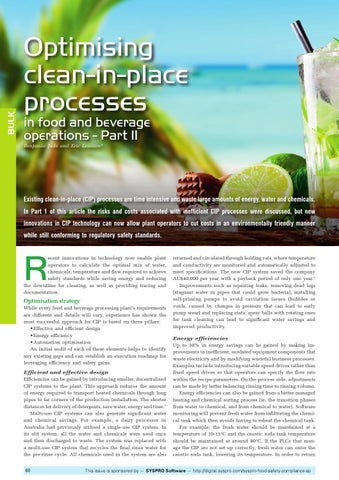BULK
Optimising clean-in-place processes in food and beverage operations - Part II Benjamin Jude and Eric Lemaire*
Existing clean-in-place (CIP) processes are time intensive and waste large amounts of energy, water and chemicals. In Part 1 of this article the risks and costs associated with inefficient CIP processes were discussed, but new innovations in CIP technology can now allow plant operators to cut costs in an environmentally friendly manner while still conforming to regulatory safety standards.
R
ecent innovations in technology now enable plant operators to calculate the optimal mix of water, chemicals, temperature and flow required to achieve safety standards while saving energy and reducing the downtime for cleaning, as well as providing tracing and documentation.
Optimisation strategy While every food and beverage processing plant’s requirements are different and details will vary, experience has shown the most successful approach for CIP is based on three pillars: • Effective and efficient design • Energy efficiency • Automation optimisation An initial audit of each of these elements helps to identify any existing gaps and can establish an execution roadmap for leveraging efficiency and safety gains. Efficient and effective design Efficiencies can be gained by introducing smaller, decentralised CIP systems to the plant. This approach reduces the amount of energy required to transport heated chemicals through long pipes to far corners of the production installation. The shorter distances for delivery of detergents, save water, energy and time.1 Multi-use CIP systems can also generate significant water and chemical savings. For example, a dairy processor in Australia had previously utilised a single-use CIP system. In its old system, all the water and chemicals were used once and then discharged to waste. The system was replaced with a multi-use CIP system that recycles the final rinse water for the pre-rinse cycle. All chemicals used in the system are also 60
returned and circulated through holding vats, where temperature and conductivity are monitored and automatically adjusted to meet specifications. The new CIP system saved the company AU$40,000 per year with a payback period of only one year.2 Improvements such as repairing leaks, removing dead legs (stagnant water in pipes that could grow bacteria), installing self-priming pumps to avoid cavitation issues (bubbles or voids, caused by changes in pressure that can lead to early pump wear) and replacing static spray balls with rotating ones for tank cleaning can lead to significant water savings and improved productivity. Energy efficiencies Up to 30% in energy savings can be gained by making improvements to inefficient, outdated equipment components that waste electricity and by modifying wasteful business processes. Examples include introducing variable speed drives rather than fixed speed drives so that operators can specify the flow rate within the recipe parameters. On the process side, adjustments can be made by better balancing rinsing time to rinsing volume. Energy efficiencies can also be gained from a better managed heating and chemical sorting process (ie, the transition phases from water to chemical, and from chemical to water). Software monitoring will prevent fresh water from infiltrating the chemical tank which then avoids having to reheat the chemical tank. For example, the fresh water should be maintained at a temperature of 10-15°C and the caustic soda tank temperature should be maintained at around 80°C. If the PLCs that manage the CIP are not set up correctly, fresh water can enter the caustic soda tank, lowering its temperature. In order to return
